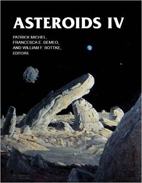
 |
Asteroids IV
edited by Patrick Michel, Francesca E. Demeo, and William F. Bottke
University of Arizona Press
To many, asteroids exist as mere space rocks of various sizes—out of sight and out of mind. To others, they are potential hazards, capable of destroying the Earth in epic Hollywood fashion. To treasure hunters, they hold potential resources—not the least of which is water beyond the hope of mineral exploitation. However, to scientists, they reveal major clues to the origin and evolution of the universe—circulating through the solar system with a unique set of characteristics and behaviors. Considered by many to be among the building blocks of planets (or planetesimals), asteroids help us understand the universe on a timeline that reaches back to the earliest periods of time as we know it.
What we know about asteroids is an ongoing science, and the picture is incomplete. At the turn of the century, around 10,000 asteroids were known. Now more than 700,000 are charted. The fascination and study is global, and a fair amount of resources have been applied toward their study. This heavy tome helps complete the picture, assembling a compendium of what is known and how we know it.
The editors of Asteroids IV have wrestled a collection of academic papers, research reports, and scientific discourse into a fairly cogent text. Weighing in at nearly one thousand pages, the mercifully brief but relatable front matter eases the reader into the current state of the science, including the most recent thoughts on the properties, geophysics, and classification of asteroids. It begins by organizing asteroids by type, population, and physical properties, as well as updates on related space missions and ground survey studies.
This overview provides only a partial view of the study, akin to staring into a box of marbles and calling them out by name, type, and number. Asteroids are moving, and this text delves into theirs dynamics, including their formation, changes, and collisions, to name a few relevant aspect of asteroid physics. This area is as essential to asteroid research as uncovering their composition. To round out this edition, the editors might have dedicated a little more time to the unknowns of the science—the frontiers and unanswered questions. Regardless, it’s difficult to argue with the scope and completeness of this edition.
Overall, this is not Sunday reading for the average person. Asteroids IV is both a central text and outlying reference for the science, periodically updated to remain as such. With all the required supporting references, the material is enticingly presented with an eye toward future exploration, as well as the troubling, albeit small, possibility of a large (i.e. 300m or greater) Earth-impact. Well edited, assembled, and organized, this an essential text for what will prove to be one of the most exciting frontiers of this millennium.
RECOMMENDED by the US Review
Next Focus Review
Previous Focus Review